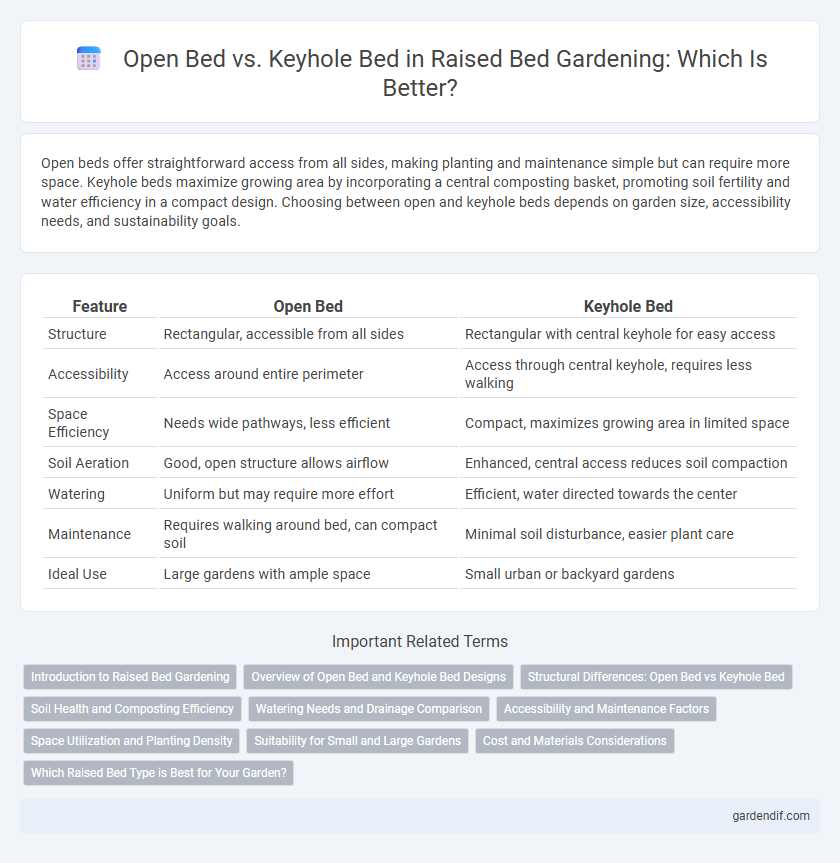
Open bed vs Keyhole bed Illustration
Open beds offer straightforward access from all sides, making planting and maintenance simple but can require more space. Keyhole beds maximize growing area by incorporating a central composting basket, promoting soil fertility and water efficiency in a compact design. Choosing between open and keyhole beds depends on garden size, accessibility needs, and sustainability goals.
Table of Comparison
| Feature | Open Bed | Keyhole Bed |
|---|---|---|
| Structure | Rectangular, accessible from all sides | Rectangular with central keyhole for easy access |
| Accessibility | Access around entire perimeter | Access through central keyhole, requires less walking |
| Space Efficiency | Needs wide pathways, less efficient | Compact, maximizes growing area in limited space |
| Soil Aeration | Good, open structure allows airflow | Enhanced, central access reduces soil compaction |
| Watering | Uniform but may require more effort | Efficient, water directed towards the center |
| Maintenance | Requires walking around bed, can compact soil | Minimal soil disturbance, easier plant care |
| Ideal Use | Large gardens with ample space | Small urban or backyard gardens |
Introduction to Raised Bed Gardening
Raised bed gardening enhances soil drainage, root growth, and weed control compared to traditional open beds. Open beds provide simplicity and accessibility for planting diverse crops, while keyhole beds optimize space and water efficiency through their circular design with a central composting basket. Selecting between open and keyhole beds depends on garden size, crop variety, and water conservation needs for effective raised bed gardening.
Overview of Open Bed and Keyhole Bed Designs
Open beds feature simple rectangular framing with accessible edges for easy planting and weeding, maximizing space and airflow. Keyhole beds incorporate a central composting area with a narrow path shaped like a keyhole, providing efficient nutrient recycling and effortless reach to all parts of the bed. Both designs enhance soil quality and plant health but differ in structure, maintenance, and nutrient delivery methods.
Structural Differences: Open Bed vs Keyhole Bed
Open beds feature a simple rectangular structure with unrestricted access on all sides, allowing easy planting and maintenance, while keyhole beds incorporate a central pathway creating a U-shaped planting area that maximizes space efficiency. The keyhole design promotes composting and watering at the center, improving nutrient distribution, whereas open beds rely on external watering and composting methods. Structurally, keyhole beds often require additional framing to support the walkway, contrasting with the minimal framing of open beds.
Soil Health and Composting Efficiency
Keyhole beds enhance soil health by concentrating nutrients and moisture in a central composting basket, promoting rapid decomposition and nutrient cycling. Open beds offer greater root expansion but may require more frequent soil amendments to maintain fertility and microbial activity. Composting efficiency in keyhole beds reduces nutrient leaching and supports healthier, more productive soil ecosystems.
Watering Needs and Drainage Comparison
Open beds typically require more frequent watering due to increased surface exposure, which can lead to faster soil drying. Keyhole beds feature a central composting basket that improves moisture retention and promotes efficient drainage, reducing overall watering needs. Enhanced drainage in keyhole beds minimizes waterlogging risks, making them more suitable for plants sensitive to overwatering.
Accessibility and Maintenance Factors
Open beds offer straightforward accessibility with unobstructed edges, allowing easy reach from all sides for planting, weeding, and harvesting, which simplifies maintenance tasks. Keyhole beds incorporate a central pathway that reduces the bed's width, improving reach to inner plants without stepping on soil, enhancing soil health and minimizing compaction. Maintenance in keyhole beds benefits from efficient design that condenses walking space, while open beds require more perimeter space but provide more overall planting area.
Space Utilization and Planting Density
Open beds offer flexible space utilization with the ability to expand planting areas, but they often result in lower planting density due to wider pathways and less efficient layout. Keyhole beds maximize space efficiency by incorporating a central access path that reduces walking space, allowing for higher planting density within a constrained footprint. This design enhances soil management and irrigation accessibility, promoting more intensive planting and optimized use of available garden area.
Suitability for Small and Large Gardens
Open beds offer flexibility and easy access, making them ideal for small gardens where space optimization is crucial. Keyhole beds, with their compact circular design and central composting area, suit larger gardens by maximizing planting density and facilitating efficient nutrient recycling. Both designs enhance soil health and crop yield but cater to different garden sizes and user preferences for maintenance.
Cost and Materials Considerations
Open beds typically require fewer materials and lower initial costs due to their simple rectangular design, making them more budget-friendly for gardeners. Keyhole beds, while often more expensive because of their intricate circular layout and central composting area, optimize space and soil fertility, potentially reducing long-term material needs. Choosing between the two depends on balancing upfront investment with ongoing maintenance efficiency and garden productivity.
Which Raised Bed Type is Best for Your Garden?
Open beds provide easy access from all sides, making planting and maintenance straightforward, while keyhole beds optimize space by incorporating a central composting area for nutrient recycling. Keyhole beds are ideal for gardeners seeking efficient water use and enhanced soil fertility in limited spaces, whereas open beds suit larger areas with simpler designs. Selecting between open and keyhole raised beds depends on garden size, accessibility needs, and desired sustainability practices.
Open bed vs Keyhole bed Infographic

 gardendif.com
gardendif.com